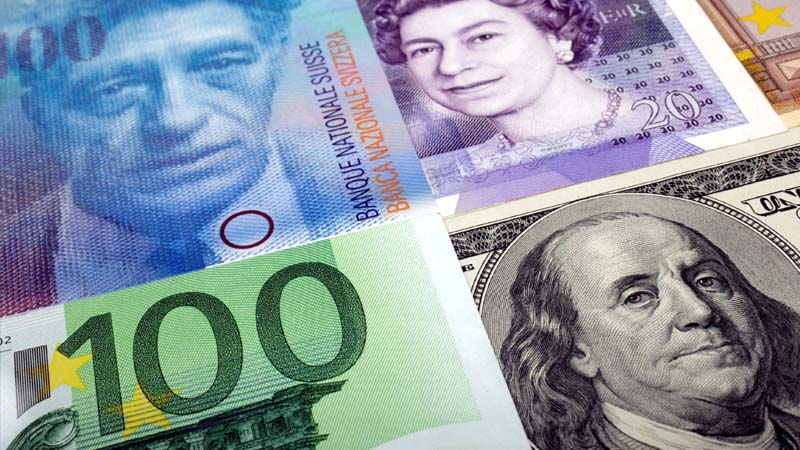Fed Rate Cuts in 2025: Will the Dollar and Euro Diverge? A Guide to Forex Dynamics and Investment Opportunities
The hottest topic in the market recently is undoubtedly the shift in the policy direction of the U.S. Federal Reserve (the Fed). As expectations for Fed rate cuts heat up, global financial markets have been on a rollercoaster ride. Especially for investors like us in the foreign exchange market, the tug-of-war between the US dollar and the euro is the center of attention. As of February 14, 2025, the US Dollar Index hovered at a high of 105.12, while the EUR/USD struggled in the 1.04 to 1.06 range. This reflects not just changes in interest rates, but a contest of strength between the two major economies. in this article, I will take you on a deep dive into the USD/EUR trend and identify practical strategies to cope with exchange rate volatility.
Policy Divergence: The Interest Rate Tug-of-War Between the Fed and ECB
To understand exchange rates, you first need to understand the calculations of the central banks on both sides. Currently, the U.S. Federal Reserve (the Fed) and the European Central Bank (ECB) are like two players in a chess game, where every move affects the flow of global capital.
Why is the Fed Pivoting to Rate Cuts? Analyzing the Economic Signals
In September 2024, the Fed’s unexpected 50 basis point rate cut officially marked a turning point in the monetary tightening cycle. Although the market claimed it was anticipated, its reaction was honest—the inversion of the U.S. Treasury yield curve worsened, which is often seen as a warning sign of an economic recession. Although the current benchmark interest rate in the U.S. remains between 4.25% and 4.5%, the core PCE price index has been below 3% for several consecutive months, easing inflationary pressures and giving the Fed more policy flexibility. The purpose of the rate cut is clear: to inject some vitality into a potentially slowing economy while keeping inflation under control, thereby avoiding a hard landing. This is a typical “precautionary cut” aimed at extending the economic expansion cycle.
The ECB’s Dilemma: Walking a Tightrope Between Fighting Inflation and Saving the Economy
On the other side, the European Central Bank (ECB) isn’t having such an easy time. President Lagarde’s statements are always artful, one moment saying she is “closely monitoring exchange rate fluctuations,” and the next expressing concern about the economic outlook. The data speaks for itself: the Eurozone’s core CPI annual growth rate is still high at 3.2%, well above the 2% target, but the manufacturing PMI has been struggling below the 50-point mark (which separates expansion from contraction) for several months. This is a standard “stagflation” risk—inflation isn’t coming down, but the economy is on the verge of stalling. In this situation, the ECB is like walking a tightrope: raising rates could hurt the economy, while cutting them could let inflation get out of control, leaving them in a policy predicament.
💡 Recommended Article
Want to dive deeper into how to interpret market trends from economic data? Recommended reading:
The Ripple Effects of Fed Rate Cuts on Global Markets
Any move by a central bank is not an isolated event; it ripples through the entire financial market. For investors, understanding these effects of Fed rate cuts is essential for positioning oneself in advance.
Direct Impact on the US Dollar Exchange Rate: A Shot in the Arm or a Stress Test?
Theoretically, a rate cut makes a currency ‘cheaper’ because the interest income from parking funds in that country decreases, naturally leading to depreciation. But this time, the situation is a bit more complex. Despite the Fed’s rate cut, the US dollar LIBOR rate remains as high as 4.8%, far above the Eurozone’s 2.5% benchmark rate. This significant interest rate differential, coupled with ongoing global geopolitical risks, has highlighted the US dollar’s role as a “safe-haven currency.” According to SWIFT data, the dollar’s share of global payment settlements has rebounded to 48.3%, a recent high. Therefore, for the dollar, the rate cut is more of a stress test than a purely negative factor.
Indirect Impact on the Euro’s Trajectory: The See-Saw Effect Emerges
The US dollar and the euro are like two ends of a see-saw. When the dollar strengthens due to risk-averse sentiment, the euro naturally comes under pressure. More importantly, the Eurozone’s own structural economic problems are coming to the forefront. A report from Germany’s IFO Institute shows that business investment sentiment has fallen to its lowest level since 2020, with a severe outflow of energy-intensive industries. This directly weakens the Eurozone’s economic foundation, leading to a sharp narrowing of the current account surplus. In such a weak fundamental environment, even if the dollar softens slightly, the euro may not gain much ground.
How Are Top Institutions Interpreting the 2025 USD/EUR Trend?
Major Wall Street firms have differing views on the future market, which illustrates the current uncertainty. Understanding their perspectives helps us build a more comprehensive market picture.
- Peak Dollar Theory: Represented by CITIC Securities, they believe that as the US rate cut cycle deepens, the interest rate differential advantage will gradually shrink, and the US Dollar Index may fall below 98 in the second quarter of 2025.
- Euro Rebound Theory: Strategists at Standard Chartered are relatively optimistic, suggesting that if the ECB can end its quantitative tightening ahead of schedule, combined with the disbursement of funds from the EU Recovery Fund, the EUR/USD could rebound to the 1.12 level.
- Range-Bound Fluctuation Theory: UBS Wealth Management reminds investors that there are still many variables in the market, such as the unwinding of the yen carry trade and debt risks in emerging markets, all of which could trigger exchange rate volatility. Therefore, they advise investors to maintain a diversified portfolio, with the US dollar and gold remaining important safe-haven assets.
Practical Investment Strategies for Navigating Exchange Rate Volatility
After understanding the macroeconomic trends, it’s crucial to implement concrete trading strategies. Different roles require different approaches. Here are a few 2025 investment strategy directions for reference.
How Can Import/Export Businesses Hedge Against Currency Risk?
For business owners with actual foreign exchange needs, ‘gambling on exchange rates’ is the biggest taboo. A combination of forward foreign exchange settlement and foreign exchange options is recommended. For example, a manufacturer exporting to Europe can pre-sell forward euros to lock in profits, and then buy a call option on the euro to retain the potential for additional gains if the exchange rate moves favorably.
How Should Individual Investors Allocate Assets Between the US Dollar and the Euro?
For individual investors, flexibility is the greatest advantage. Consider allocating some funds to US dollar money market funds (e.g., Vanguard Federal Money Market Fund) to enjoy interest rates higher than savings accounts while maintaining liquidity. For those looking to buy the dip in the euro, it is advisable to buy in batches and treat it as part of a long-term asset allocation rather than short-term speculation. Additionally, pursuing global asset allocation through ETFs is also a good way to diversify single-currency risk.
💡 Recommended Article
How to find safe-haven opportunities in a volatile market? Understanding VIX ETFs might be your next step. Recommended reading:
2025 FOMC Meeting Schedule and Key Points to Watch
For traders, keeping a close eye on the FOMC meeting schedule is fundamental. These are not just the days when interest rate decisions are announced; the post-meeting statement and the chairman’s press conference often contain clues about future policy directions.
|
2025 FOMC Meeting Schedule Information |
||
| FOMC Meeting Dates | FOMC Rate Decision Announcement Time | Interest Rate |
| 2025/1/28-2025/1/29 | 2025/1/30 3:00 AM | 4.25%~4.5% |
| 2025/3/18-2025/3/19 | 2025/3/20 2:00 AM | To be announced |
| 2025/5/6-2025/5/7 | 2025/5/8 2:00 AM | To be announced |
| 2025/6/17-2025/6/18 | 2025/6/19 2:00 AM | To be announced |
Frequently Asked Questions (FAQ) about Fed Rate Cuts
Here are a few of the most frequently asked questions, answered in plain language.
❓Will stocks always rise after a US rate cut?
Not necessarily. It depends on the ‘reason’ for the rate cut. If it’s to stimulate a moderately growing economy (a precautionary cut), the lower cost of capital is generally positive for the stock market. However, if the cut is in response to a severe economic recession or financial crisis (a rescue-type cut), the market may interpret it as bad news, and stocks could continue to fall.
❓What does the benchmark interest rate mean?
Simply put, the benchmark interest rate is the rate at which the central bank lends money to commercial banks. It serves as the ‘pricing foundation’ for the entire financial system’s interest rates. By adjusting this rate, the central bank can influence bank lending and deposit rates, thereby controlling the overall money supply in the market to stimulate or curb the economy.
❓How often does the Fed meet?
The Federal Open Market Committee (FOMC) holds eight regularly scheduled meetings per year, about once every six weeks. During these meetings, they assess economic conditions and vote on whether to adjust the federal funds rate. Of course, they can also convene unscheduled meetings in response to significant events.
Conclusion: Seizing Opportunities Amidst Change
In summary, the 2025 foreign exchange market will be a fascinating game between the pace of Fed rate cuts and the policy response of the ECB. The US dollar may remain strong in the short term due to safe-haven demand and interest rate advantages, but its medium-to-long-term trend is full of variables. The euro, on the other hand, faces a severe test of its economic fundamentals. For investors, understanding the logic behind the Fed rate cuts and developing flexible strategies is crucial. This is not a market where one can make one-sided bets with closed eyes, but one that requires constant vigilance and the ability to find structural opportunities amid volatility. Continuous learning is the key to remaining invincible in the financial markets.
*The content of this article is for sharing and reference purposes only, and does not constitute professional investment advice. As individual circumstances and needs vary, you may contact the Cashback Island team or consult your financial planner for professional advice.
Related Articles
-
As the announcement of the 2025 Budget on February 26, 2025, approaches, Hong Kong society is closely watching how the government will balance the need for relief measures with structural reforms amidst the pressure of its HK$680 billion fiscal reserves. Financial Secretary Paul Chan Mo-po's recent emphasis on "precision in...2025 年 10 月 11 日
-
The Hong Kong Securities and Futures Commission (SFC) officially granted operating licenses to two cryptocurrency trading platforms—PantherTrade and YAX—on January 27, 2025, further promoting the compliant development of Hong Kong's crypto market. Since launching its licensing program in mid-2024, the SFC has issued licenses to seven Virtual Asset Trading Platforms...2025 年 10 月 11 日
-
As the U.S. Consumer Price Index (CPI) for January exceeded expectations, market forecasts for the Federal Reserve's future monetary policy shifted, causing the U.S. Dollar Index to rise rapidly and leading to a pullback in gold prices. However, despite this pressure, the gold market still shows potential for growth, primarily...2025 年 10 月 11 日












